
Origin of the Dorsal Fringe on Mosasaurs
Copyright © 2000-2013 by Mike Everhart
Updated 01/13/2013
 |
Origin of the Dorsal Fringe on Mosasaurs Copyright © 2000-2013 by Mike EverhartUpdated 01/13/2013 |
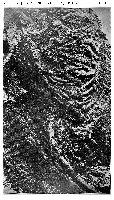 |
Ever wonder why some mosasaur
pictures, especially older illustrations like those by Charles Knight, show a dorsal
fringe and some don't? The idea originated with a faulty interpretation by S. W.
Williston of a wonderfully preserved specimen found in Logan County, Kansas. The
fossil mosasaur [Platecarpus ictericus, KUVP
1001] was found by Albin Stewart in 1898 and included scales, preserved sternal
cartilage and "a row of dermal processes." The specimen was first reported by
Williston in a brief editorial note (scanned version shown below) in The Kansas University
Quarterly that same year, which was then followed by an short
article and a photograph published by Williston (1899; Plate XII at LEFT). That same year, H. F. Osborn (1899) found the same structures preserved in a large Tylosaurus proriger from western Kansas and interpreted them correctly as tracheal rings. However, he also credited Williston for his discovery of the 'nuchal fringe' and published an image by Charles Knight that showed the fringe. Russell (1967, page 88) briefly discusses "cartilaginous structures in the thoracic region of mosasaurs" and diplomatically states that both Williston and Osborn had seen similar "tracheal structures" in these "two excellent skeletons from the Niobrara chalk." |
In Williston's defense, he (1902, p. 254) did recognize the error and included the following statement in his discussion: "In conclusion, I wish to correct an error made by myself. That which I considered to be the nuchal fringe in the mosasaurs is evidently only the slender cartilaginous rings of the trachea, first described and figured by Professor Osborn. I have no excuses to make for the mistake, which I recognized when too late to correct."
| Editorial Notes. ________________ During the past summer the University Geological Expedition in western Kansas was very fortunate in securing a most extraordinarily good specimen of a Platecarpus, which adds, unexpectedly, some new facts in their structure. The specimen was discovered by Mr. A. Stewart a mile and a half from Elkader on the Smoky Hill River, and includes the complete animal to the base of the tail. The skin was preserved entire, but, when exposed to the air, very much of it has flaked off. By the use of shellac, however, considerable patches have been preserved. The scales are similar to these of Tylosaurus, but are somewhat larger, and apparently lack a prominent carina. A remarkable peculiarity is the presence of a row of dermal processes along the nucha, from the skull at least as far back as the thoracic region. How much further they may go it is impossible to say, since the bones lie above the posterior end of them. They are about three millimeters in diameter and four or five, perhaps six, inches in length, forming a thick fringe or mane; and resembling very much the thongs along the legs of buckskin trowsers. The sternal apparatus is preserved entire and apparently, like most of the bones, nearly in position. There is a true, bony sternum, of crescentic shape, with a projecting, flattened, spatulate episternum. The paddle shows the outline of the membrane which joins the body broadly, and has the fifth finger divaricated. There are five carpal bones. Photographic figures of the nuchal fringe, the sternal apparatus and the skin, together with some observations on the food-habits of the animal will be given in the next number of this Quarterly [Williston, S.W. 1899. Some additional characters of the mosasaurs] S. W. Williston. (235) KAN. UNIV. QUAR., VOL. VII. No. 4, OCT. 1898, SERIES A [This specimen (KUVP-1001) is currently on exhibit in the Museum of Natural History at the University of Kansas, in Lawrence, KS.] |
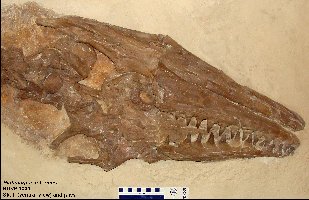 |
LEFT: The skull of KUVP 1001 (Platecarpus ictericus)..
elements of the preserved cartilage rings of the trachea are shown at
upper left. Note that, as prepared, the skull is in ventral (palate) view
with the right lower jaw shown in lateral view.
RIGHT: A view of the neck region of KUVP 1001, showing the preserved cartilage rings of the trachea above the cervical vertebrae. The area in the oval apparently came off during preparation and is mounted with the specimen...note that it is a mirror image (counter-part) of the area shown below, and includes several of the cervical ribs. |
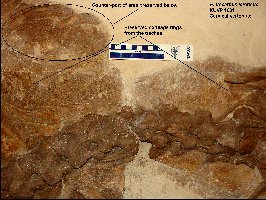 |
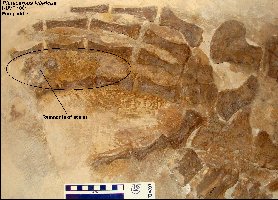 |
LEFT: The paddle described by Williston showing the shape
in life and some remnants of the scales preserved with the specimen. The
scales are very fragile and have suffered in the last 110 years from preparation
and cleaning. Note that shellac was used initially in preserving the
remains.
RIGHT: The preserved "crescentic" sternum described by
Williston ... I would argue that much of it is actually composed of
cartilage. Williston's comments on "some observations on the food-habits of the animal"
are related to small fish bones, including
this 3 mm vertebra, that were associated with the specimen. Williston
noted “Not the least interesting
information furnished by this specimen is that concerning the food of the
animal. Quantities of its remains were discovered in the abdominal region,
matted together and more or less comminuted. A close examination of these
remains discloses nothing but fish bones, and usually only those of small
size. The largest observed is a vertebra of an Empo
[Cimolichthys], or some allied fish; of about four
feet in length.” |
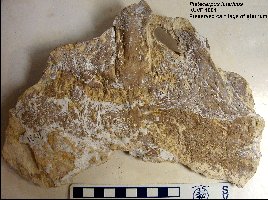 |
Everhart, M.J. 2005. Oceans of Kansas - A Natural History of the Western Interior Sea. Indiana University Press, 322 pp.
Osborn, H.F. 1899. A complete mosasaur skeleton, osseous and cartilaginous. Memoirs of the American Museum of Natural History 1(4):167-188.
Williston, S.W. 1898. Editorial Notes. Kansas University Quarterly 7(4):235.
Williston, S.W. 1899. Some additional characters of the mosasaurs. Kansas University Quarterly 8(1):39-41, Plate XII.
Williston, S.W. 1902. Notes on some new or little-known extinct reptiles. Kansas University Science Bulletin, 1(9):247-254, 2 pl.